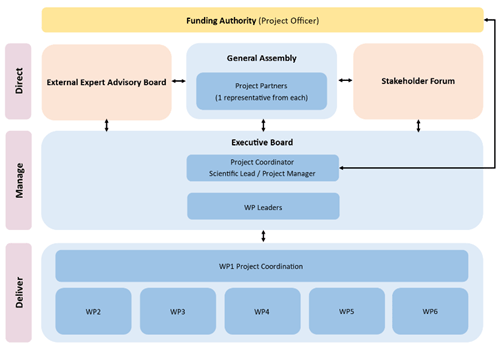Contact
fiona.reid@slu.se, +46 18 67 3242, +46 72 2288689

Most funders will ask you to describe your work plan and potentially also your management structure, decision-making mechanisms and risk minimisation/mitigation strategy in your proposal. They may also recommend that you include a work package (WP) or defined tasks to handle project coordination activities - particularly in collaborative projects. It’s important to take the time to do this clearly and convincingly - the evaluators must believe that the project will be organised and run efficiently, with attention to detail, and in a way that will ensure results are delivered on time and within budget.
Your project implementation plan, coordination activities and management structure should be appropriate for the scale of your project - the number of partners and the size of the budget. The example below is suitable for a medium-large collaborative project, where the number of partner organisations is larger than the number of WPs. However, it is adaptable to smaller or larger projects. Of course, you also have to consider how much space you have available to write - 500 words or 5 pages - and adjust the level of detail accordingly.
Each funder will likely ask for specific information about your work plan, but to give a good overall picture, you can answer questions such as:
If your project has, for example, multiple partners, multiple WPs and/or a large budget, our advice is to include a distinct WP for project coordination. This can demonstrate to the evaluators that you understand the importance of good quality project implementation. It’s also an opportunity to show that you have considered the need to allocate time, resources and budget to these activities in your project plan.
It’s important to formulate your project coordination objectives and activities according to the funder's requirements, the call text, proposal/evaluation requirements, and your own project context. Try to replicate the funder's terminology and relate your strategy to any special or unique concepts within your proposal.
Examples of project coordination objectives, which form the basis of your tasks and activities, could include:
If you include both a dedicated WP and a separate section on projection coordination in your proposal, make sure that you don’t waste space by repeating text in two places. Write the information once and add cross-references in the text (e.g. “see section X for more detail”.) Evaluators are limited on time; they don’t want to read the same information twice.

It’s usually a good idea to include a figure to show your planned management structure (if the proposal template allows for this). The example below is a typical structure for a medium-large collaborative research project but could be easily adapted to fit other project sizes and types. When designing such a figure, the critical thing to remember is to include every management group and show how they relate to each other (with arrows).
This example structure generally conforms to the DESCA Model Consortium Agreement - the most common model used in EU projects, but adaptable to any collaborative project. As well as signing a Grant Agreement with the funder, collaborative projects are often required to sign a Consortium Agreement between the partners. Using a management structure from a template (such as DESCA) in your proposal can make the process of preparing the Consortium Agreement easier.
If possible, you should describe all of the management groups or roles represented in your management structure figure in your proposal text. Where relevant, explain who is involved, what their responsibilities are, how decisions will be made and how often they will meet. For more guidance and suggestions on describing your management structure, please see our detailed breakdown of our example structure, available to download here.
In an ideal world, every project would run smoothly from beginning to end. However, there will always be differences of opinion in real life, and these can lead to conflict. You can reduce the effect of any potential disputes by making a plan for conflict resolution.
In your proposal, before you describe your process for resolving conflict, it is valuable to explain what measures you will implement to avoid or minimise conflict from arising in the first place. This can include actions such as:
Despite the mitigation measures you have outlined, should disputes or difficulties arise, you should have a clear and straightforward process for managing them. This process should be appropriate to the scale of your project, and, for the example above, could be:
For severe matters, an extraordinary meeting of the General Assembly may be called to discuss and deal with the dispute. The General Assembly will propose a resolution to the conflict, and any differences of opinion between the members will be put to a vote.
In a project coordination context, risks refer to plausible events or issues that could adversely impact the ability of the project to achieve its objectives - i.e. these are risks relating to project implementation.
It is not a negative thing to show that there are risks involved in your project - if a proposal claims that a project has minimal or no risk, then it suggests that you may not be taking big enough steps to go beyond the current state of the art. Risk in itself is not bad - it shows that you understand the challenges you face - the critical factor is demonstrating that you also have contingency plans to mitigate risk or change direction if things don’t go to plan.
Describe your risk assessment and contingency plan - these questions can help to form your response:
Often, you are asked to provide a list of potential risks to project implementation in your proposal. This should not be an exhaustive list but should show that you have considered the different types of challenges that the project could face. If there is no mandatory table for you to use in the proposal template, then as a minimum, you should aim to describe:
Section 6 of DESCA contains a description of the Governance Structure for the project. The examples we have used above generally conform to this suggested governance structure.
Detailed advice from SLU Grants Office on how you could organise your organise your project management structure, in line with the DESCA Consortium Agreement
For anyone looking to develop more in-depth skills and knowledge - PM2 is a project management methodology developed by the European Commission. It was developed with the needs of EU Institutions in mind but is transferable to projects in any organisation. PM2 is an easy-to-implement methodology, and a complete set of documentation is available online for free.
As always, you can reach out to the Grants Office to ask questions at any time. Contact us at grantsoffice@slu.se.
fiona.reid@slu.se, +46 18 67 3242, +46 72 2288689